The Holy Bible and its living in the” Liturgy”
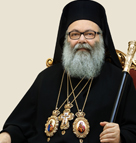 The Holy Bible and its living in the ”Liturgy”
The Holy Bible and its living in the ”Liturgy”By His Beatitude John X Patriarch of Antioch and All the East
Before I speak on the relationship between the holy Bible and the Liturgy, it could be useful, if I define what “Liturgy” is first, and then what the Holy Bible is, second, then, we speak on the living of the Bible, in or through the liturgy.
First “Liturgy” shortly, is the divine worship. By this, I mean the divine service, the sacraments, or (mysteries) through which we receive fully our Lord and savior, Jesus Christ.
“Liturgy” is the Life of our Lord Jesus Christ we celebrate in the Christian Feasts, and in other occasions, in the Holy Church. Now, I refer to some of them, by means of an example: Christmas, the Divine Theophany, Transfiguration and the like, in which, and through which, we remember the life of our Lord, on earth.
The Orthodox Liturgy, is also, in the divine sacraments that help us and make us partake of the life of the Lord, and lead us, and initiate us, into the Life of Jesus Christ, really and truly .The divine Eucharist can also offer us, the Lord’s Divine, and precious body and blood.
On the basis of what has been mentioned, the Orthodox Liturgy, is what we do throughout the liturgical year, in all its sessions, and Cycles, whether be they in the daily Cycles in our Prayers, or in the weekly ones, as in the prayers scattered over the whole week. Or even in the yearly ones too.
In the Liturgy, our Lord Jesus Christ, in his person, looks down upon us in all sense of the word, not symbolically or figuratively, nor even by illusion; He looks down on us, with his beloved face and countenance; we partake of him, and get initiated into his sufferings, death and Resurrection; We really die with him in the Liturgy. This takes place when we die for our old Man, and then are risen again, or resurrected, new in the Lord, in all sense of the word too; this is what the Orthodox Liturgy is about. It is the act that initiates us into the life of Jesus Christ, and helps us partake of his life, really and truly.
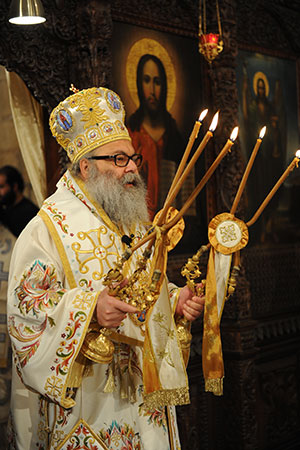

Now in doing that we participate in Christ’s suffering which he bore and endured on the cross, on behalf of us .Then, we get and receive all the blessings that stem from the Holy Cross, Resurrection, Life and Salvation…. On the other hand, the Holy Bible is the most important divine inspiration for the salvation of mankind.
The Holy Bible was written by ordinary people. By this, I mean, the holy Apostles, the men of God who, by inspiration of the Holy Spirit, wrote it.
The Word of God is our Lord Jesus Christ. And the Holy Bible is the narrative of Salvation, whose core is the Divine Resurrection of our Lord, the Word of God. Liturgy offers us, rather introduces to us, the Lord Jesus Christ. And the Holy Bible is the Word of God. And the Word of God is our Lord Jesus Christ himself. Later on, I am going to speak on this, with more details.
From what has been mentioned, we come across the fact that the Holy Bible and the Liturgy, do not discuss, or speak about two separate topics, because the Bible and the Liturgy, grant us the one and the same thing.
There is the great mystery of piety that St. Paul speaks about in (1 Tim 3:16); it is the Lord Jesus Christ himself. Around this mystery, the Holy Bible rotates, and so does the Liturgy.
We speak of Jesus Christ who is the great mystery of piety that appeared in flesh, in the fullness of time, for our Salvation. Therefore Liturgy grants us the Lord himself; and the Holy Bible, is the Word of God, in that I mean Jesus Christ himself, too.
The truth is one: the Lord Jesus Christ is in the Liturgy and in the Bible, and in the prayers, in general. It is in The Holy Tradition, and in the whole Life of the Holy Church. All these are different aspects of an act and experience in the holy spirit, in the Church, and in the lives of the Holy Fathers, and in all the faithful who experience the Life of our Lord Jesus Christ, the only mystery, the A and the W, the First and the Last, in our lives.
Now, I am going to discuss some ideas on the coherence, cohesion and the relationship between the Holy Bible and the Liturgy; The Holy Bible in regard to Liturgy, is the first and most important source of Liturgy. I cite examples in that regard; we notice in the mid-night prayers, the “Orthros”, the Hours, Vespers and the small prayer before going to bed, in the Divine Liturgy and Sacraments, a basic station or topic which is the Holy Bible. We all know that the beginning of the Divine Liturgy is as follows: “Blessed is the Kingdom of the Father, the Son and the Holy Spirit ……” after that, follows a collection or a group of hymns: “By the intercessions of the Theotokos savior save us”, with what follows; Then the Little Entrance, then “God is Holy…” (Trisagion hymn). Then the Epistle and the Gospel. In the structure of the Divine Liturgy it is very important that parts from the Bible (The N. Testament) are read with parts from the Acts and the other epistles.
We notice that the Holy Bible is basic in the Liturgy. Here, a lateral remark must be mentioned:
In the first centuries of Christianity, the Church used to recite More than one text in the Divine Liturgy. We usually read one part of an Epistle (usually from the Acts of the Apostles), and another from the Gospel. Whereas, in the past, four or five texts used to be read; two from the Old Testament (Torah and the prophets), and three (from the N. Testament). This was the custom observed in Antioch. But later on and for reasons associated with shortening the service, it has been arranged that two only, are to be read… We also notice the presence of hymnological parts (for psalmody and singing), all extracted as they are, from the Holy Bible. We cite some by means of an example. A hymn we all know about in the evening prayer (vespers) “Lord, now lettest thou thy servant depart in peace according to thy word: for my eyes have seen thy salvation thou hast prepared in the presence of all peoples a light for revelation to the Gentiles, and for glory to thy people Israel” (Luke 2:29). This is a hymn uttered by St. Simeon the moment he received the Lord as a baby on his arms. We also hear: “My soul magnifies the Lord, and my spirit rejoices in God my savior. For he has regarded the low estate of his handmaiden for behold, henceforth all generations will call me blessed” .This is sung during Orthros and is accompanied by: “More honorable than the Cherubim…”. All these are extracted from the New Testament to be used in the liturgical prayers. Wherefore, the Holy Bible, and in particular the N. Testament, is a principal source of the Liturgy.
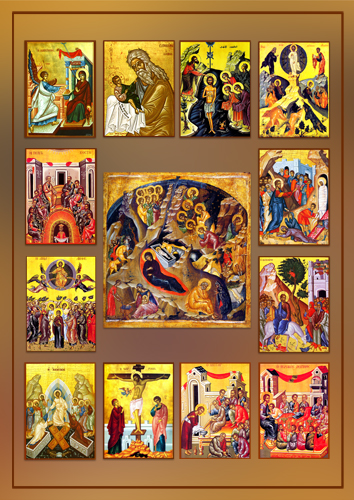 Now, let’s meditate for some time, on some feasts in the Liturgical Year. There are feasts dedicated to the Lord such as “Christmas”, “the Divine Theophany”, and “Easter”. There are also some other feasts dedicated to the mother of God “Theotokos” as: “The Dormition of the mother of God”, and “the birth of the mother of God”. There are also other feasts dedicated to saints (martyrs, archbishops, and other holy persons ….).
Now, let’s meditate for some time, on some feasts in the Liturgical Year. There are feasts dedicated to the Lord such as “Christmas”, “the Divine Theophany”, and “Easter”. There are also some other feasts dedicated to the mother of God “Theotokos” as: “The Dormition of the mother of God”, and “the birth of the mother of God”. There are also other feasts dedicated to saints (martyrs, archbishops, and other holy persons ….). If we have a look at the structures of the feasts, we find that their roots are based on the Bible. The feasts pertaining to the Lord, are also taken from the Bible (Gospel) with The acts of the apostles. For instance, when we celebrate the “Divine Theophany” we celebrate the episode referred to in the N. Testament when the Lord came to the Baptist to be baptized by him in the Jordan River. There are saints whom we celebrate every year. They are mentioned in the N. Testament. We also celebrate the prophets, and other saints that have been mentioned in the Old Testament.
The Liturgical calendar is built up on a biblical background, for it depends on the life of the Lord when he appeared among us as a man assuming our body from the most holy mother of God Mary, for our salvation.
If we meditate on the Holy Week, the sufferings of the Lord, His crucifixion, His Burial, Resurrection, and His ascent to the heavens, with the sending of the Holy Spirit …. Where did these feasts come from ?
The Great Holy Thursday, Crucifixion, the suffering service (with the 12 Gospels), Christ’s funeral on the Great Friday, the Saturday of Lazarus, and the descent into the Hades, with the glorious resurrection (The Holy Easter).
This series of feasts has not been improvised, but it rather came from the Holy Bible, from the N. Testament, from what has been said of the Lord himself, and known about him in the Holy Tradition, in the Church.
When we speak on the holy Bible as a source of the Liturgy, we must necessarily remember the Liturgical and ecclesiastic norms available and in use, in the Church whose source is the Holy Bible too: For example, Fasting, the Prayers in general, and the time of each prayer, and others. We see that the ascetic and spiritual practices which have a character associated with prayer, worship and the rituals, are reported in the Holy Bible…. The Lord himself fasted. Men of God in the Old Testament fasted. The Holy Apostles fasted. From them we took our custom and practice to fast and to know how to.
The Liturgical language is taken from the Holy Bible too. We say for example: The holy baptism, the mystery of Chrismation, the mystery of the sacred anointing, the Holy Eucharist, the Lord’s Table… and other liturgical expressions. All these expressions or in other words, the so-called “liturgical dictionary”, come from the Holy Bible. More than that, many liturgical Services like the Holy Eucharist, Chrismation, are performed today, exactly the way the Holy Apostles used to perform them, with the effect of the Lord’s Life, besides the Apostles, in the N. Testament. Now we perform the mysteries as they had been handed down to us, since the apostles themselves received them from the Lord. And how is the Eucharist performed?
The Lord Jesus Christ, in the mystical supper, dined with his disciples and said to them: “do this in remembrance of me …”. The Acts of the Apostles says: “…..all these with one accord devoted themselves to prayer, together with the women and Mary the mother of Jesus, and with his brothers…” (Acts 1:14). The Holy Apostles exercised the Holy Eucharist from the beginning, and reported to us, everything they did. We in turn, received everything, and still do what they used to do, then.
For this reason the apostle Paul says: “I received from the lord what I handed down to you. “Jesus” our Lord, on the night he was taken in, took the bread, and thanked …. whenever you eat from this bread, or drink from this cup, you speak of the lord until he comes” (1 Corinthians 1 :23).
If we read the two chapters (11 and 14) from the First Epistle of St Paul to the Corinthians, we see the apostle speak on the table of love, on the Eucharist, Which the church used to perform, then. He gives some recommendations in this regard. Our services and rituals like (the Holy Baptism, the Holy Eucharist, and others, are deeply rooted in the Holy Bible, from the liturgical data in the Holy Bible, and particularly in the New Testament. We find the service built, and it is what we perform today. From the remarks the Apostle reported, we notice the presence of biblical readings, I mean parts taken from the Holy Bible. Wherefore, we see the Holy Bible as a basic and essential source of the Liturgy.
Second, it is convenient and suitable too, to remember that the Liturgy has affected, to a great extent, the text of the Holy Bible .The liturgy has kept the Word of God. When the text of the Bible was written, the liturgy was lived and experienced among the faithful communities. The Liturgy played a great role in the formation of what had been written. No doubt, this was done by the inspiration of the Holy Spirit. Now, I am going to quote some examples on that too:
There are three sections in the New Testament that report the sitting of the Lord with his disciples in the last supper for establishing the sacrament of The Eucharist. The first is a part from the gospel according to St. Mathew. The second from the Gospel according to St. Luke. The third from St. Paul. If we read these sections, we notice that they have one content despite some differences in the text. I will try to explain this:
We read in the gospel according to St. Mathew: “And as they were eating, Jesus took bread, blessed and broke it, and gave it to the disciples and said, "Take, eat; this is My body. "Then He took the cup, and gave thanks, and gave it to them, saying, "Drink from it, all of you. For this is My blood of the new covenant, which is shed for many for the remission of sins” (Matthew 26:26 – 28 ).
But in the Gospel according to St. Luke the text says: “Then He took the cup, and gave thanks, and said, "Take this and divide it among yourselves; for I say to you, I will not drink of the fruit of the vine until the kingdom of God comes. "And He took bread, gave thanks and broke it, and gave it to them, saying, "This is My body which is given for you; do this in remembrance of Me" (Luke 22 : 17 – 19).
But St. Paul in (1 Corinthians 11: 23-26) says: “For I received from the Lord what I also passed on to you: The Lord Jesus, on the night he was betrayed, took bread, and when he had given thanks, he broke it and said, “This is my body, which is for you; do this in remembrance of me.” In the same way, after supper he took the cup, saying, “This cup is the new covenant in my blood; do this, whenever you drink it, in remembrance of me”. For whenever you eat this bread and drink this cup, you proclaim the Lord’s death until he comes.
This text is also important for the Holy Tradition.
Therefore, we have three texts in accord, according to content, yet different in form or structure. We heard what St. Paul said: “I handed down to you, what I received from the Lord.” The apostles were completely faithful to the Lord when handing down what they had received, without increasing or decreasing anything. Wherefore, the Apostolic Tradition is the Church rule or criterion, because The Apostles received the Good News, and they themselves handed it down as they received it. That is why St. Paul says: “But even if we, or an angel from heaven, preach any other gospel to you than what we have preached to you, let him be accursed” (Galatians 1:8).
The Apostles were so precise and accurate in handing down what they had received from the Lord. The question that stems now is: why did they leave three different texts? How is that explained?
The explanation is simple: We know the New Testament was written between 60 and 90 AD. The Acts of the Apostles informs us that the faithful used to gather to break the bread. In Jerusalem they used to gather to break the bread. The same was done in Antioch and in Alexandria. They also used to repeat the words they learned from the Lord. These texts used to be said in the Local traditions and in the liturgical observances during the Eucharist, here and there. And when the other books, of the New Testament were written, in later phases, they were written as they had been taken from the Lord. The formation of these texts had great impact on the local observances and performances in all the Churches. The critics agree, besides many researchers of the field, that the texts were written as exactly as they used to be read in liturgical meetings. Later on, the Fathers used them with the Apostles and the Gospel authors. For example St. Paul uses the following expressions in his Epistles: “The Grace of our Lord Jesus Christ be with you all” (Romans 16:24).
This is a Eucharistic text. We hear it today in the Divine Liturgy when the celebrant priest says from the royal door: “The Grace of our Lord Jesus Christ, and the love of God the Father, with the Holy Spirit, be with you all”. This Eucharistic text was taken from St. Paul to be used in the Holy Bible.
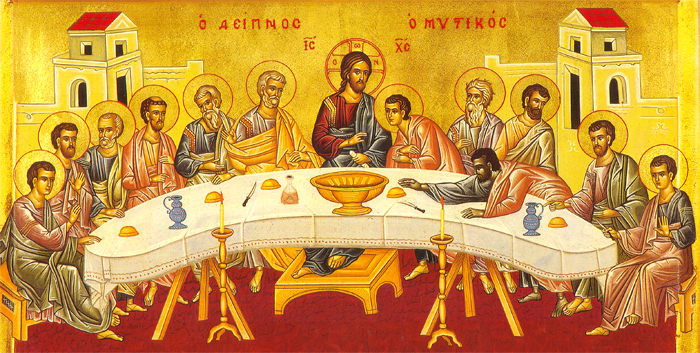
The Lord Jesus Christ is the “Mystery of Piety”. The Holy Bible and the Liturgy, introduce the Lord Jesus Christ to us. In the Epistles to the Philippians, the Apostle says: “In your relationships with one another, have the same mindset as Christ Jesus: Who, being in very nature God, did not consider equality with God something to be used to his own advantage; rather, he made himself nothing by taking the very nature of a servant, being made in human likeness. And being found in appearance as a man, he humbled himself by becoming obedient to death — even death on a cross! Therefore God exalted him to the highest place and gave him the name that is above every name, that at the name of Jesus every knee should bow, in heaven and on earth and under the earth…” (Philippians 2:5–10). This text was also used in the Eucharist and in the liturgical gatherings.
From what has been mentioned, we find that the Holy Bible, on one side, is the source of the liturgy in many cults, observances, customs, norms, and feasts. On the other hand, the Holy Bible was written in the Church which was living by, and according to the Holy Spirit, the Mystery of Chirst in the Liturgy. The Bible came from living in the Church which is basically built up in the Liturgy. In the Eucharist (the breaking of the bread), with the prayers and fasting, and others .The Holy Bible was born by the inspiration of the Holy Spirit, and out of this life. The Bible and the Liturgy are inter-mingled.
Thirdly, we are certain that the Holy Bible is contained in the liturgy. When we look deep into the liturgical books “the Hours”, the Triodion, Pntikostarion, which we use between Easter and Pentecost, with the Oktoikhos (the eight tones, “comforter”) which we use after Pentecost, until We move into the great lent again. We also use the “Menaion” (monthly). The Menaion has the feasts of the Saints commemorated daily. We see that these books contain biblical material that covers a great section of the book.
Now if we lose the whole text of the New Testament, we can through the liturgical books, reconstruct the original one (the New Testament). The original text of the New Testament is contained and distributed as successive recitations in every feast and occasion, in the Orthros, Vespers, and the Psalms. We also notice that during The Great Lent, and in the Triodion, there are some new Biblical sections. In the 6th Hour, for example we read parts from Isaiah. And in the Vespers, we do read parts from the Genesis and the Proverbs. And when The Great Lent is over, we can have read Isaiah, Genesis, and Proverbs, through the Triodion, in the Church.
The recitation of some parts of the Holy Bible even their interpretation, were and still represent a basic element in the Liturgy; this is something we notice in all the divine services. In the service of the Holy Marriage, parts of the epistles and gospels are read. The same we notice in the services of (the Funeral, the Holy Baptism, and the Divine Liturgy, and in the services associated with the feasts of the Saints, with the Orthros, and the Vespers…).
Fourthly, the Liturgy is written in a biblical spirit. The Holy Saints who wrote the biblical texts, knew the Holy Bible, by heart. When they wrote these hymns, the text was full of the spirit of the Bible. I quote some examples:
We read during, the first week of the Great Lent, in the evening Lenten prayer, the Canon of St. Andrew of Crete. When we read this Canon, we Notice that the St. is full of the biblical Spirit. Both the Old and the New Testaments were well built, the canon is rich with the Spirit of the Holy Bible.
We also notice that the Saint cries with petition “Lord have mercy on me”. This petition is the Stichon which is repeated on all the parts of the canon. And the cries themselves that the Saint raises are full of piety, repentance, Contrition (katanixis), and dignity. We also notice how the Saint expresses his feelings by means of different hymns, and how each is similar to a poetic poem, in which he uses different images and different personalities from the Holy Bible which shroud the repenting human soul with either avoiding the ugly aspects of some Biblical personalities or with acquiring the virtues of other good people. For example we mention a part where he speaks of Lut when he says: “My soul, run away like Lut from every evil act. Run away from Sodom. Run away from the flames of every beastly desire or lust – (Part 2, Ode 3). My soul, do not become a pillar of salt, looking back. Be horrified by the Living of the Sodomites” (Part 4, Ode 3).
We notice that the Saint appeals to the use of people and events from the Holy Bible to project upon the human soul. We also read Ode 9: “My soul I quoted parts from Moses on the creation of the world, and from that, every book sets a date of the unjust. Yet, you did not imitate the former ones, but competed with the latter when you sinned to God. My Soul, I brought you some patterns from the new book by which you could be taken to piety and contrition. Therefore, be jealous of the just, and evade the sinners supplicating to the Lord Jesus Christ with prayers and fastings, with purity and dignity in the heart. Jesus took our flesh calling thieves and whores to repentance. Repent you my soul, for the door of the kingdom is opened for you. The Publicans with the Pharisees will approach to take hold of it, if they come back to the Lord. Jesus has redeemed the Magi, called the shepherds, and announced the children to be martyrs. He honored Simeon with the old widow whom you never wished to imitate my soul, neither in acts nor in life. Woe to you when it is time to be judged”.
“The Lord who fasted in the wilderness forty complete days finally was hungry as to show the human aspect in him. So, do not be negligent my soul when the enemy attacks you, but rebut him with prayer and fasting to make him withdraw and run away completely”.
It is noteworthy right here, to mention that the Triodion which we use in our Church during the Great Lent opens its prayers with the Sunday of the Publican and the Pharisee, with the following hymn: “Brethren, let us not pray like the Pharisee, because everyone who lifts himself is lowered. Rather let us be humiliated before God with real humility. Let’s sing as we fast like the publican who says: “Lord forgive me the sinner”. This has the background of the Pharisee and the publican as mentioned in the Gospel According to St. Luke (9-14).
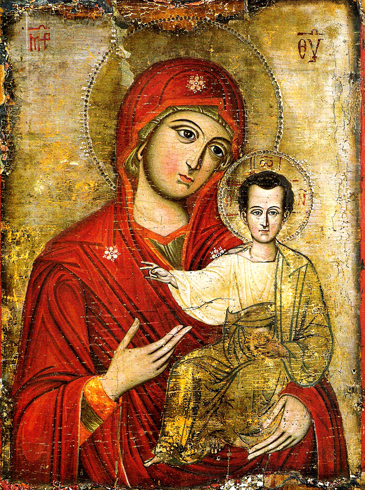 We quote another example which is very beautiful: During the Paraklesis which we celebrate during the fast dedicated to the mother of God, August 1 to 15. The Greek word Paraklesis, means the supplication we raise to the Theotokos (the mother of God). The Paraklesis is a canon composed of a group of hymns. The first part of each Ode, the measure, the rule, the initial pattern, the poetic measurement for all the Troparia, with all the parts that follow. Opposite to that, in the Holy Bible, there are groups of hymns we call biblical hymns which we use in our worship, in the Orthros during the Great Lent Moses’ hymns, Habakkuk’s hymns, Daniel’s, the three Children thrown into the furnace without being hurt.
We quote another example which is very beautiful: During the Paraklesis which we celebrate during the fast dedicated to the mother of God, August 1 to 15. The Greek word Paraklesis, means the supplication we raise to the Theotokos (the mother of God). The Paraklesis is a canon composed of a group of hymns. The first part of each Ode, the measure, the rule, the initial pattern, the poetic measurement for all the Troparia, with all the parts that follow. Opposite to that, in the Holy Bible, there are groups of hymns we call biblical hymns which we use in our worship, in the Orthros during the Great Lent Moses’ hymns, Habakkuk’s hymns, Daniel’s, the three Children thrown into the furnace without being hurt. If we consider the part of each Ode in the Paraklesis, and compare its content with the other hymns, we notice the following: There are nine hymns used in the Liturgy. There are other nine hymns in the Paraklesis which coincide with Biblical hymns opposing them. (I mean the part of the first Ode, with the first hymn, and the third from here, with the third on the other side, and the 9th with the 9th). Therefore, the liturgical text which is a hymn for the Virgin Mary, taken from the Holy Bible, is written with the Spirit of the Holy Bible. We quote an example:
”The Israelis walked on Humidity As if walking on Land running away from the Egyptian hardships. They cried and said: we praise our God and savior” (Paraklesis, the first Ode).
The hymn tells of the Exodus of the Israeli people from Egypt, and their crossing over the red sea. The first hymn from the Holy Bible (Exodus 15) tells of the same subject when Moses stood and praised the Lord after departing from Egypt. Yet, the 6th Ode in the Paraklesis says: “I pour down my supplication before The Lord ,and I tell him of my distress, because my soul is full of evil thoughts and my life is close to the Hades. “I beseech you Lord crying like the prophet in the whale’s belly: Lift me of corruption, my God”.
This is the subject of the 6th biblical hymn (Jonah, chapter 2) which Jonah uttered in the belly of the whale… so is the 9th biblical hymn: “My soul magnifies the Lord, and my spirit is delighted with God my savior, for he looked at the humility of his maiden”, which is a part of the Gospel according to St. Luke (6:1) used in the Liturgy with the hymn… “more honorable than the Cherubim…” which is repeated as a stanza after each verse in the hymn.
Therefore, there is a sort of intermingling, of coinciding, of real living and experiencing of what the Holy Bible is. And this experience has been moulded, because the Great Mystery of Piety which is Jesus Christ himself, in texts, whether be it the N. Testament or the Liturgical texts (the hymns used in worship).
At last, we mention that the Holy Bible is also interpreted after the prayers, the prostrations and living in the church. And here I quote two examples:
1- We recite and read in every Divine Liturgy, right after the epistle and the Gospel, a small prayer in which we trample the physical desires until we hear the word that makes us live. By this I mean the Gospel. In the Church we are sure that the Holy Bible is the word of God; and the Word of God is not read, nor interpreted, like any other word in books.
The Word of God is read and interpreted for us, only to understand. And through these words we reach at what the Lord desires for us, because the word of God is for your sakes, and the Holy Bible is not a history book, nor a story. The Holy Bible is not an ordinary book, and its interpretation is not like any interpretation at all. For example we say in the Acts of the Apostles “to them he presented himself alive after his passion, by many proofs appearing to them during forty days and speaking of the kingdom of God” (Acts 1: 3 ). But in the text, we do not find what he was saying to them. Is it possible that what the Lord said is without value, that the Apostles did not write it? This is the Tradition the Saint was talking about. That is why we are certain that the Holy Bible is not like any other book.
2- Now I quote another example. In the Gospel according to St. Luke (24) we hear about the Disciples of Emmaus: Jesus appeared to those two while they were on the way home. He walked with them, and they did not know him despite the fact they were among his disciples. When the sun was about to set, He walked into their house to dine with them. And when they sat to eat “he took Bread and after thanking he broke and gave them to eat so their eyes were opened and then they knew him”. He kept walking with them all day, yet they did not know him. Not only that, but also they said: “are you the only stranger in Jerusalem? But when he ate with them and broke the bread, they knew him (a performed Liturgical act). Here we wonder: If the two disciples walking with him did not know him, what about those who read the Bible? Do not they know Him ?
The two Disciples did not know him until He broke the bread. Only then were their eyes opened. This is the Liturgy that introduces the Lord to us. As the text of the Bible is the word of God, and the word of God is the Mystery who came and the Church accepted Him, lived with Him, preserved Him and transferred Him through the Liturgy, in a written text, and through oral giving to people. The liturgy introduces the Lord to us as we said above. The Bible is the word of God who is the Great Mystery of Piety, and the Mystery of Piety is the Lord himself. The Truth is the Lord Jesus Christ himself. And the receiver of the Truth, its carrier and interpreter, is only the Church. The Lord gives himself through His grace and with the intercession of the Theotokos, and all the Holy Fathers. Through all these, the power of the Lord is given to help our eyes open, so that we can discover the Truth which is Jesus Christ himself.
The bible is the word of God: Jesus Christ. The Liturgy introduces one thing to us: Jesus Christ. Jesus Christ is the A and the W in our lives. He sanctifies every man coming to the world, so that we can be with those who satisfied him in his glory unto ages of ages. Amen.

2025-12-09
Patriarch JOHN X’s Address at…
2025-12-06
2025-12-04
Celebrating the Feast of Saint…
2025-12-01
Address of Patriarch JOHN X The…
2025-11-24
Delegation from the Hungarian…







